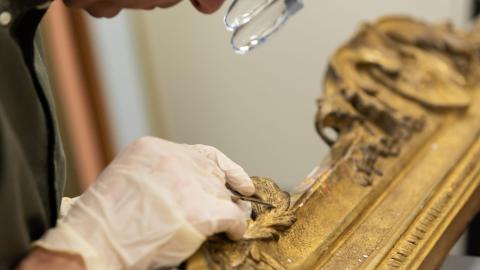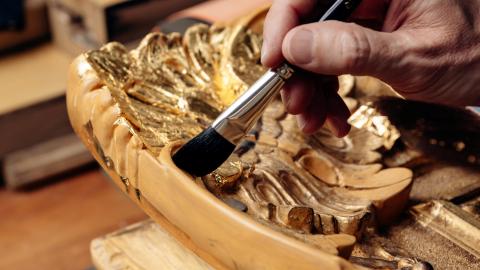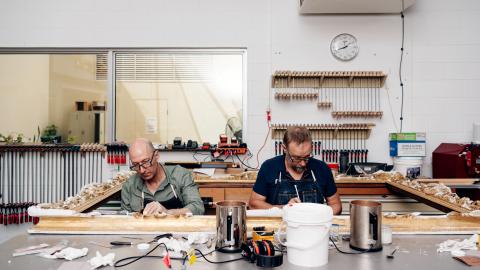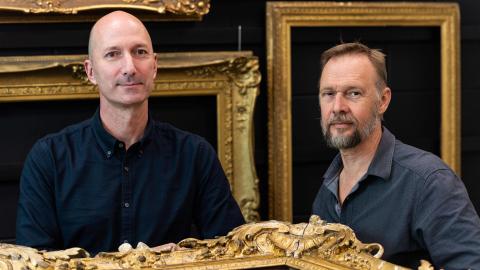Meet the conservators
Robert Zilli and Damian Buckley
Behind the scenes at QAGOMA, whole teams of curators, designers, conservators and builders help transform our galleries for each new exhibition. In a small room closed off from the dust and bustle of the main framing studio, expert artisans Robert Zilli (Conservation Framer) and Damian Buckley (Conservation Framing Technician) tend to the oft-overlooked part of artworks: their frames.

Robert Zilli and Damian Buckley, QAG Framing Studio, August 2022 / Photograph: N Harth, QAGOMA
Robert Zilli, Conservation Framer
My journey started in Italy. After graduating high school, I was looking for an apprenticeship in cabinet-making — there was nothing available. A family holiday to Italy sparked my interest in antiques and restoration, and then I came back to Australia looking for something to do in the field of furniture restoration — nothing available there either. Someone suggested, ‘Why don’t you have a look abroad?’ I lived and studied in Florence for two years! When I returned, with a diploma in antique wood restoration, I began volunteering at the Gallery, one day a week, under Paul Curson, who was then the QAG artisan framer. He was doing similar work to what we are doing. That led to a traineeship, which led to me applying for the job as the artisan framer when Paul retired. That was around 1995, I think — I’ve been here ever since.
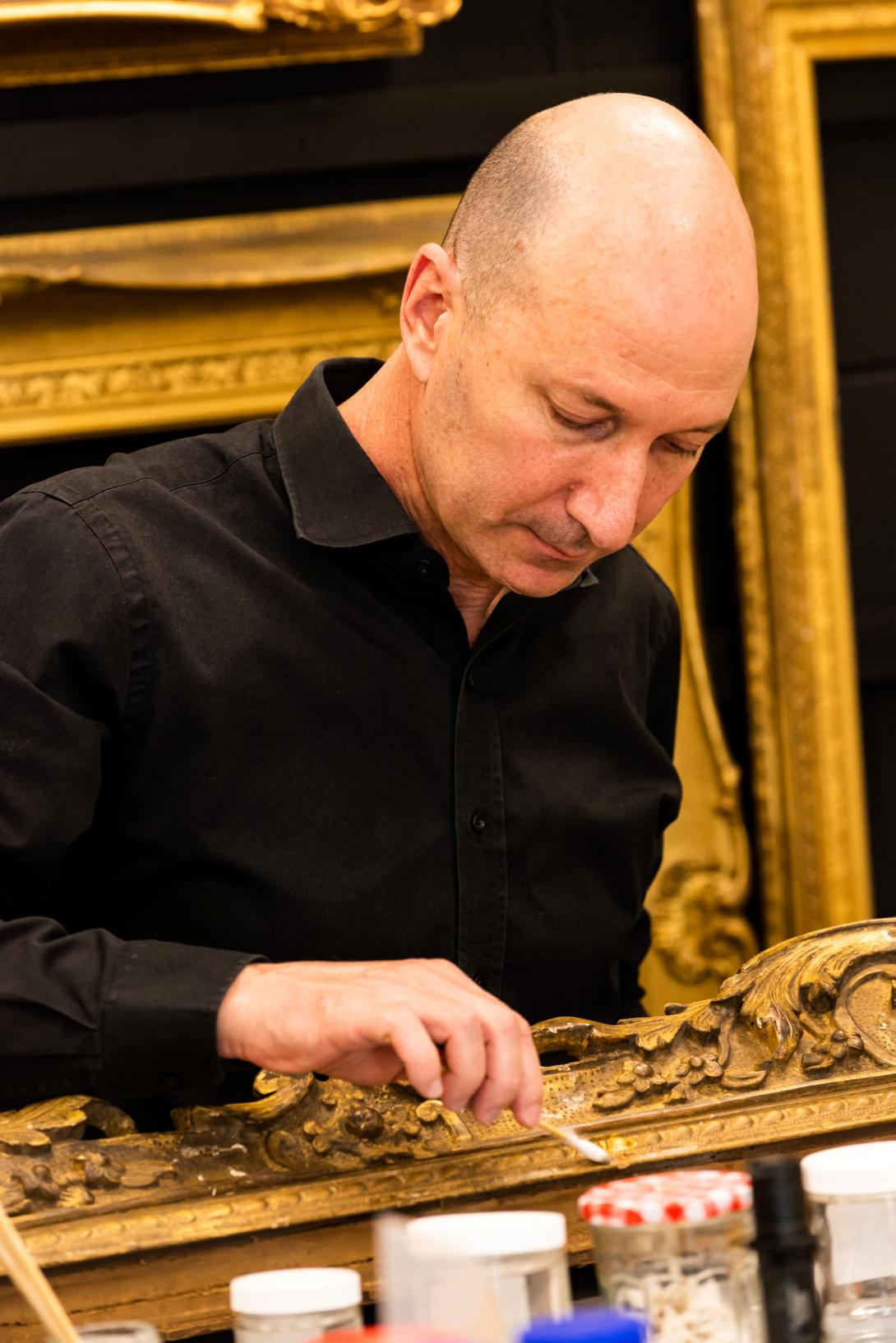
Robert Zilli, QAG Framing Studio, August 2022 / Photograph: N Harth, QAGOMA
Damian Buckley, Conservation Framing Technician
I have a background in visual arts and I’m qualified as an art teacher — but I only have that qualification because I was interested in making art. I still have a painting practice; that’s my main intellectual outlet. I became interested in picture-frame making because I wanted to house my own works in something more traditional, and I was just not satisfied with what I was seeing on offer in the commercial world. I was visiting galleries and seeing frames on old historic works. I knew Anne Carter [QAGOMA Conservator, Paintings] — she suggested I come in and have a chat about different framing techniques. Eventually I started working upstairs [at QAG], just putting frames together. And then I was slowly helping out down here [in the framing studio]. At some point it became permanent — that’s how I ended up here. (It’s killing my suntan, though.)
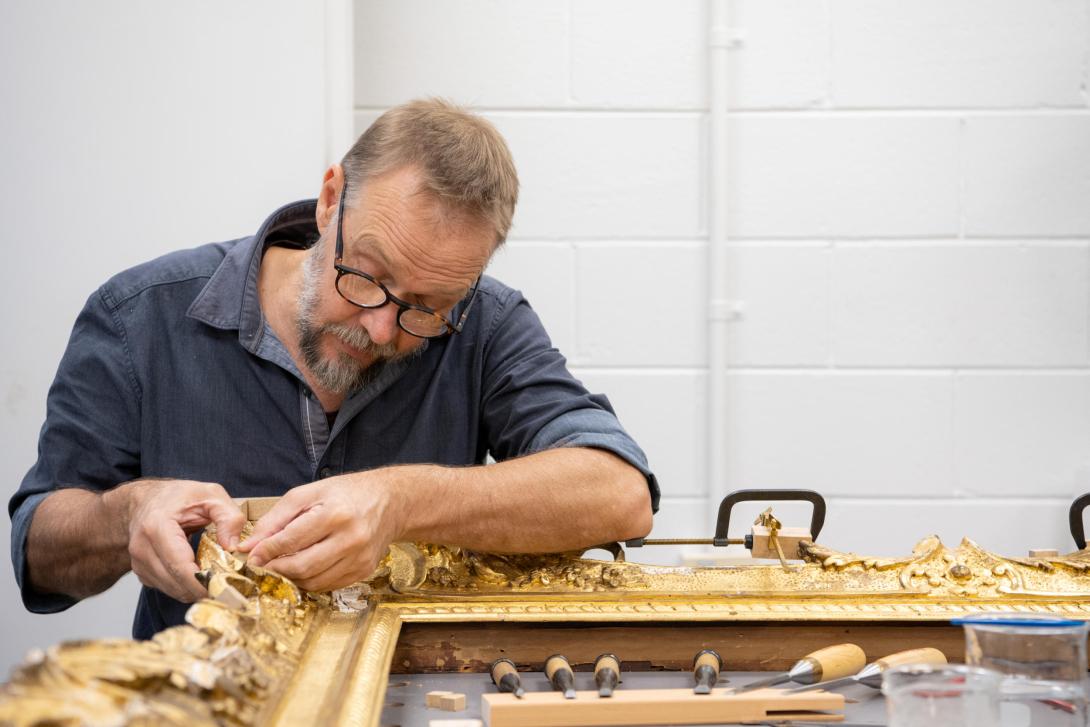
Damian Buckley, QAG Framing Studio, October 2022 / Photograph: Chloë Callistemon, QAGOMA
What’s changed during your careers?
DAMIAN BUCKLEY: One of the big changes of the past 20 years or so is less reluctance to glaze paintings. It’s becoming more prevalent for a couple of reasons: one is the quality of glazing — the results you can get are really very good. Here, we use acrylic glazing, which we can cut to any size in-house. It’s light, it doesn’t break, it’s flexible, and it really protects the painting — and we’re talking about delicate, sensitive old paintings out there with the public every day. So to have that layer of environmental protection and even a physical barrier on them is great. Robert and I do quite a lot of that sort of work as well, because we are trying — with the least intervention possible — to put glazing in a traditional frame.
ROBERT ZILLI: Like you’ve said, there’s been a big shift towards acceptance of the benefits of glazing. There’s also been the use of non-traditional materials, especially on this project here [the Romney frame, pictured below]. Again, Damian’s training as an artist and mine in Italy were based heavily on traditional methods and materials, which we still use when we’re restoring and conserving frames and furniture. But having Margaret here, we looked at the advantages of using non-traditional adhesives and cleaning methods, which I think we will be embracing a lot more often. So that was a great learning opportunity for both of us.
DB: Even the use of the cross-sections we took.
RZ: Yeah — a more scientific examination of works, before treatment, can reveal all those layers of gilding and regilding. They look like a layer cake — or licorice all-sorts.
DB: We suspected the frame had been re-gilt, but we hadn’t really picked there would be so many layers. It was great to be forearmed with that information before we physically started intervening with the frame; it helped tell us what we were seeing sooner.

Robert and Damian work on the Romney frame in the QAG Framing Studio, October 2022 / Photograph: C Callistemon, QAGOMA
How do you know when a frame is finished?
DB: People always ask, ‘How do you know when it’s done?’ It’s like building a house: you know it’s done when all those little points are constructed soundly and all the i’s are dotted, t’s are crossed. You know when it’s done. All the steps, for us, are very clear-cut. For instance, we’ll have to re-gesso parts of the [Romney] frame; gesso is a beautiful material: it is brushed on in a liquid form and it ends up with a hard, marble-like finish. [Gesso is a surface primer that traditionally includes glue and chalk.] The gesso must be applied, then sanded to a flawless surface before you go on to the next stage.
RZ: Yes, you need to finish the previous step to go on to the next. Once all the gesso losses have have been filled and the carving and gilding completed, the final step is toning the bright gold to match it back in to the colour of the existing gold. Then there’s putting the painting in — in this case, with a new backing board. But for conservation work on the frame, the final-final step is toning and patination of the gold leaf. You don’t want to have really bright areas of gold next to gold that’s 150 years old.
DB: That’s probably the most subjective of the processes.
RZ: It’s also difficult, because the lighting in here is different to the lighting in the galleries! And you’re very aware of your own repairs, so your eye always gets drawn to that area. You know that leaf is a new leaf and you’ve re-carved and regilded that particular section, where someone else might go, ‘I can’t see anything’.
DB: But by that time, we’ve spent months going over and over the surface of the frame, looking for every flaw.
